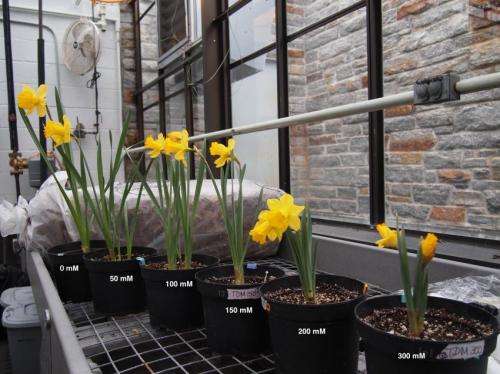Three popular daffodil varieties determined to be highly salt tolerant

As the world's diminishing fresh water resources are increasing allocated for human use, agricultural and horticultural production operations must rely more often on the use of brackish, saline, or reclaimed water for irrigation. These saline-rich water sources often contain electrical conductivities that can negativity affect plants' ability to thrive. Salinity is particularly problematic for ornamental plants such as daffodils because of the potential for damage to plants' aesthetics and visual qualities.
In the September 2014 issue of HortScience, Maren Veatch-Blohm, Douglas Sawch, Nicole Elia, and Dominic Pinciotti from the Biology Department at Loyola University, Maryland, presented a study of 'Tete-a-Tete', 'Dutch Master', and 'Ice Follies' daffodils. These three early to midseason cultivars are consistently ranked in the top five daffodils for sales and production. "Our previous research showed that moderate salinity (up to 50 mM NaCl) did not have an effect on growth or flower production of these three cultivars regardless of when salinity exposure began," noted lead author Veatch-Blohm. "In this study we wanted to determine levels of salinity these three cultivars could tolerate while maintaining visual quality."
The scientists planted narcissus bulbs in October each year for 3 consecutive years, and examined how salinities ranging from 0 to 300 mM NaCl affected growth, flower production, and leaf physiology of the three cultivars. Analyses showed that anthesis (the time during which the flowers are fully open) and flower duration in 'Tete-a-Tete' were unaffected by salinity, but the number of flowers produced was negatively affected (reductions of 50% or more) by salinities of 150 mM NaCl and above. Sodium accumulation occurred at or above 50 mM NaCl in 'Tete-a-Tete', but at salinities greater than 150 mM NaCl in 'Dutch Master' and only in the 300-mM NaCl treatment in 'Ice Follies'.
"Despite the Na+ accumulation in the leaves, the plants in most of the salinity treatments were able to maintain a K+:Na+ ratio above 1, which may have helped the daffodils tolerate the negative effects of Na+ and maintain good visual quality," the authors said.
"'Tete-a-Tete', 'Dutch Master', and 'Ice Follies' demonstrate salinity tolerance, which further increases their desirability for cut flower production and landscapes. Interspersing irrigation with high-quality water or a higher leaching fraction may even enable these daffodil cultivars to tolerate short-term exposure to even higher salinities, which would be particularly useful for commercial growers. We recommend that these varieties can be grown in pots for cut flower production without substantial loss of visual quality with irrigation water with an NaCl induced EC of up to 12.81 dS•m-1," noted the authors.
The scientists added that the three narcissus cultivars studied may be good candidates for planting in salinized landscapes.
More information: The complete study and abstract are available on the ASHS HortScience electronic journal web site: hortsci.ashspublications.org/c … t/49/9/1158.abstract
Journal information: HortScience
Provided by American Society for Horticultural Science

















